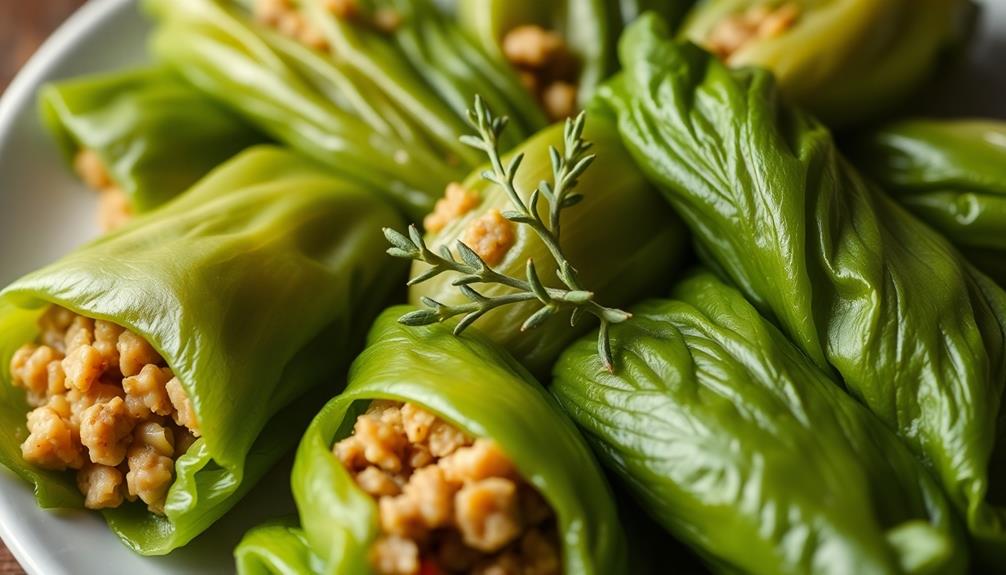Bigos, also known as Hunter's Stew, is a beloved Polish dish that'll warm your heart and soul. You'll love this hearty mix of sauerkraut, fresh cabbage, and various meats simmered to perfection. It's a centuries-old recipe that's perfect for cold winter nights and family gatherings. The flavors deepen over time, making it even tastier the next day. You'll enjoy tearing crusty bread to soak up the rich sauce. Bigos is more than just a meal; it's a taste of Polish history and culture. Dive in to discover the secrets of this comforting stew and how to make it your new favorite dish.
Key Takeaways
- Bigos is a traditional Polish stew combining meats, sauerkraut, and fresh cabbage, often called Hunter's Stew.
- Key ingredients include various meats, sauerkraut, fresh cabbage, onions, red wine, and aromatic spices.
- The stew is typically simmered for hours, allowing flavors to meld and improve over time.
- Bigos has cultural significance in Poland, often served during festive occasions and family gatherings.
- It's an ideal dish for batch cooking, freezing well and tasting better when reheated.
History
Some believe Bigos, a hearty Polish stew, dates back to the 14th century when it was popular among hunters and nobility. You might imagine these early hunters returning from a long day in the woods, eager to warm up with a steaming bowl of this rich, flavorful dish.
Over time, Bigos became a staple in Polish cuisine, loved by people from all walks of life. You'll find that Bigos has evolved throughout history, with each region adding its own special touch.
In the past, it was often prepared in large quantities and left to simmer for days, allowing the flavors to meld and intensify. This slow-cooking method made it perfect for long, cold winters when fresh ingredients were scarce.
During festive occasions, you'd see Bigos served as a centerpiece, bringing families and communities together. It's fascinating to think about how this simple stew has played a role in Polish culture for centuries.
Today, you can still enjoy Bigos in homes and restaurants across Poland, where it continues to warm hearts and stomachs alike.
Recipe
Bigos, also known as Hunter's Stew, is a hearty and flavorful Polish dish that has been enjoyed for centuries. This traditional stew combines a variety of meats, sauerkraut, and fresh cabbage, simmered together with aromatic spices and dried mushrooms to create a rich and satisfying meal.
The beauty of Bigos lies in its versatility and the depth of flavor that develops as it cooks. Often prepared in large quantities, this stew improves with time, making it an ideal dish for batch cooking or entertaining. While recipes may vary slightly from region to region or family to family, the core ingredients and cooking method remain consistent.
- 500g sauerkraut, rinsed and drained
- 500g fresh white cabbage, shredded
- 500g mixed meats (pork, beef, and kielbasa sausage), cubed
- 100g smoked bacon, diced
- 2 onions, chopped
- 2 apples, peeled and grated
- 30g dried porcini mushrooms, rehydrated
- 2 tbsp tomato paste
- 2 bay leaves
- 1 tsp caraway seeds
- 1 tsp juniper berries
- 250ml red wine
- Salt and pepper to taste
In a large pot, cook the bacon until crispy, then add the onions and sauté until translucent. Add the cubed meats and brown them. Stir in the sauerkraut, fresh cabbage, rehydrated mushrooms, apples, tomato paste, and spices.
Pour in the red wine and enough water to cover the ingredients. Bring to a boil, then reduce heat and simmer for 2-3 hours, stirring occasionally. Add more liquid if needed. The stew is ready when the meats are tender and the flavors have melded together.
For the best results, prepare Bigos a day or two in advance and reheat before serving. This allows the flavors to develop fully. If the stew becomes too thick upon reheating, add a little water or broth to thin it out.
Serve Bigos hot with crusty bread or boiled potatoes on the side. The stew can be frozen for up to three months, making it an excellent option for meal prep or for enjoying the taste of autumn year-round.
Cooking Steps
Get ready to create a hearty bigos by gathering your ingredients and equipment first.
You'll then brown the meats and vegetables, adding layers of flavor to this classic stew.
As the dish comes together, you'll incorporate sauerkraut and mushrooms, letting everything simmer for hours until it's rich and delicious, perfect for serving with crusty bread. For an added touch of savory goodness, consider grating some oscypek cheese over the top before serving. The smoky flavor of the cheese will complement the earthiness of the mushrooms and the tanginess of the sauerkraut. This hearty dish is sure to satisfy any comfort food cravings.
Step 1. Gather Ingredients and Equipment
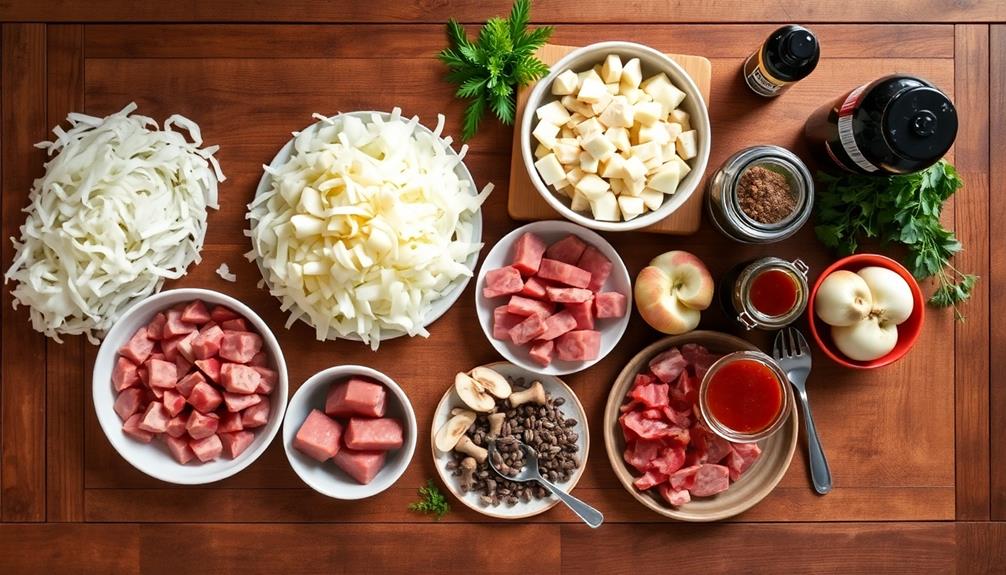
Before diving into the cooking process, round up all the necessary ingredients and equipment for your bigos.
You'll need a large, heavy-bottomed pot or Dutch oven to cook this hearty stew. Gather your sharp knives and cutting boards for chopping the various meats and vegetables. Don't forget a wooden spoon for stirring!
For ingredients, you'll want to collect an assortment of meats like pork, beef, and kielbasa. Fresh and sauerkraut cabbage are essential, along with dried mushrooms, prunes, and your choice of vegetables.
Make sure you have tomato paste, red wine, and bay leaves for added flavor. Spices like caraway seeds, marjoram, and black pepper will bring everything together.
As you collect these items, you might feel a sense of excitement building. The rich aromas of bigos will soon fill your kitchen!
Lay out all your ingredients on the counter, and double-check that you haven't forgotten anything. With everything at hand, you're now ready to embark on your bigos-making adventure.
Let's get cooking!
Step 2. Brown Meats and Vegetables
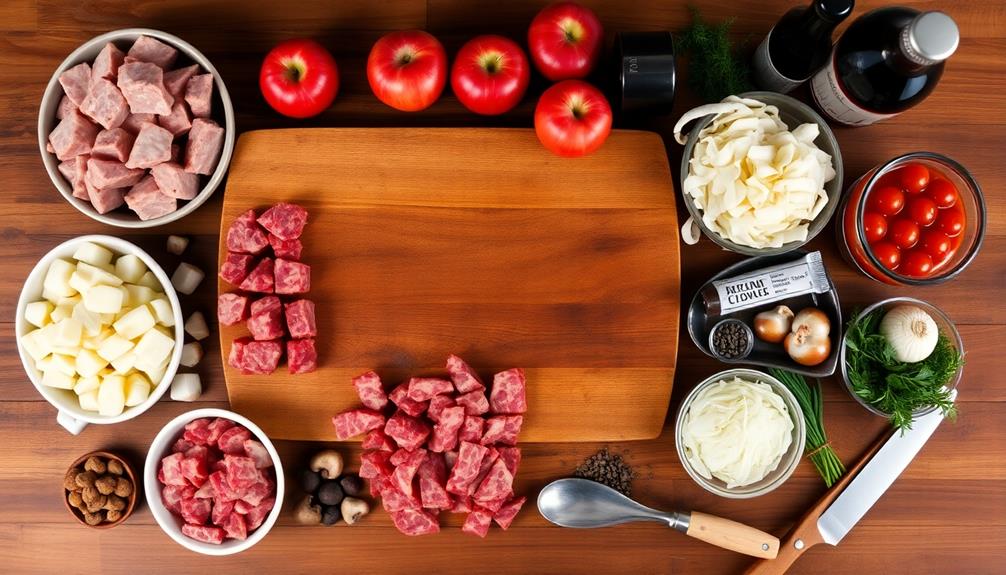
Now that you've gathered your ingredients, it's time to kick off the cooking process. Start by heating a large, heavy-bottomed pot over medium-high heat. Add a splash of oil and let it warm up.
Once it's hot, toss in your cubed beef and pork. Watch as they sizzle and brown, stirring occasionally to ensure even cooking. The meat will develop a rich, golden crust that's packed with flavor.
Next, add your chopped onions to the pot. They'll start to soften and turn translucent, releasing their sweet aroma. Toss in the sliced mushrooms and let them cook down, absorbing all the delicious meat juices.
Don't forget to add your minced garlic – it'll fill your kitchen with an irresistible smell!
As everything cooks, you'll notice the bottom of the pot developing a brown layer. Don't worry, that's flavor gold! Use a wooden spoon to scrape it up, mixing it back into the meat and vegetables.
This process, called deglazing, will give your bigos a deep, rich taste that'll have everyone asking for seconds.
Step 3. Add Sauerkraut and Mushrooms
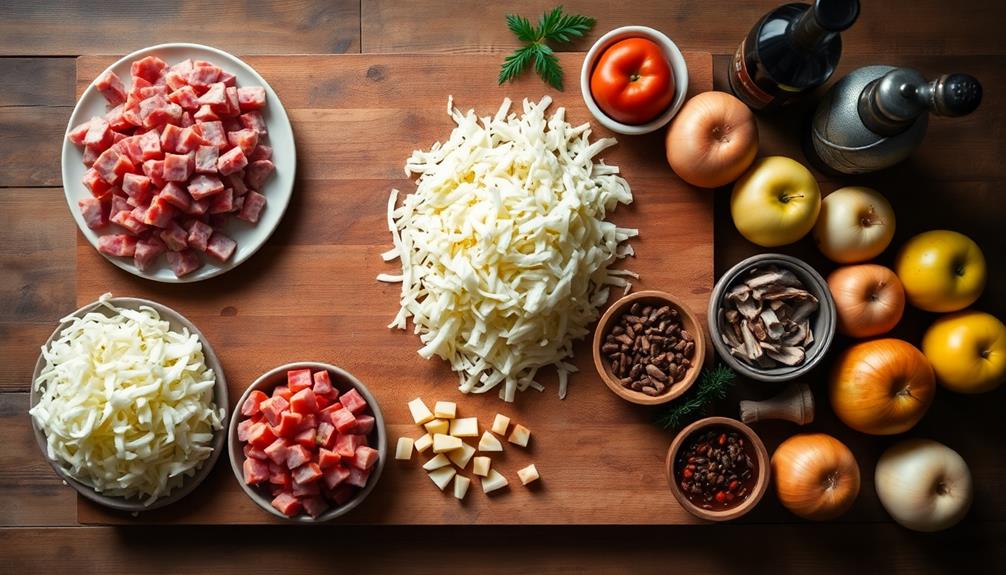
The star of the show is ready to join the party. It's time to add the sauerkraut and mushrooms to your bigos.
Drain the sauerkraut, but don't rinse it – you'll want that tangy flavor to shine through. Chop it roughly if the strands are too long. Now, toss it into the pot with your browned meats and vegetables.
Next, grab your mushrooms. If you're using fresh ones, slice them up. Dried mushrooms work great too, but you'll need to soak them first. Add the mushrooms to the mix, stirring everything together. The earthy flavor they bring will complement the sauerkraut perfectly.
As you stir, you'll notice the incredible aroma filling your kitchen. That's the magic of bigos happening right before your eyes!
The sauerkraut will start to soften and meld with the other ingredients, creating a harmonious blend of flavors. Don't worry if it looks a bit crowded in the pot – everything will cook down and become a delicious, hearty stew.
You're well on your way to creating a classic Polish dish that'll warm you from the inside out!
Step 4. Simmer for Several Hours
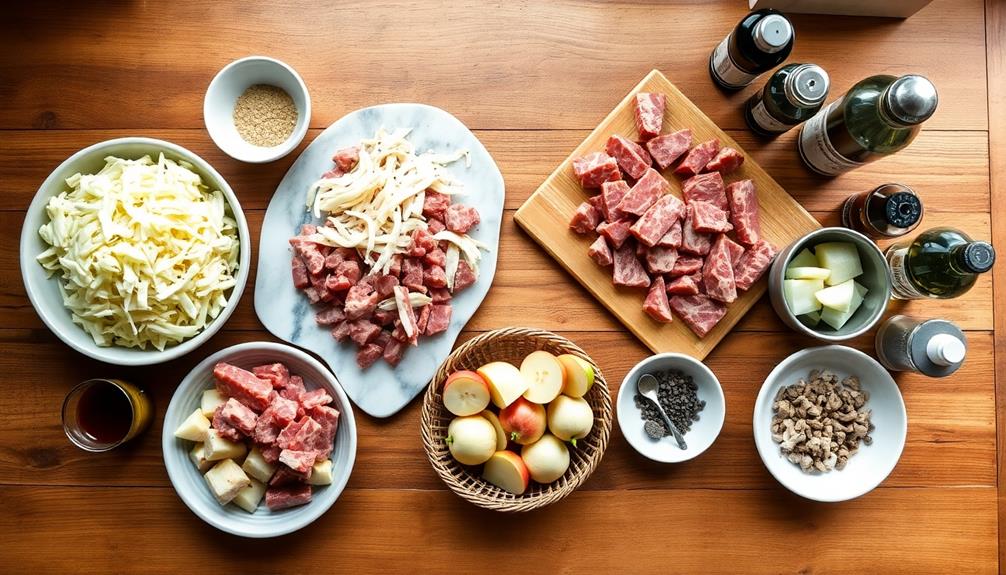
With all the ingredients combined, it's time to let the magic happen. Now, you'll want to bring your pot to a gentle simmer. Cover it partially, leaving a small gap for steam to escape. This slow cooking process is where bigos truly comes to life!
Let the stew bubble away for at least 2-3 hours, stirring occasionally. You'll notice the flavors melding together, creating a rich, hearty aroma that'll fill your kitchen.
As time passes, the meat will become tender, and the cabbage will soften, absorbing all those delicious flavors.
Don't rush this step – the longer you simmer, the better your bigos will taste. Some cooks even let it simmer for up to 5 hours! If you find the stew getting too thick, add a splash of water or broth to keep it moist.
Remember to taste and adjust the seasoning as you go. The flavors will intensify over time, so be patient.
When you're happy with the taste and consistency, your bigos is ready to serve. Get ready for a comforting, flavorful meal that's worth the wait!
Step 5. Serve With Crusty Bread
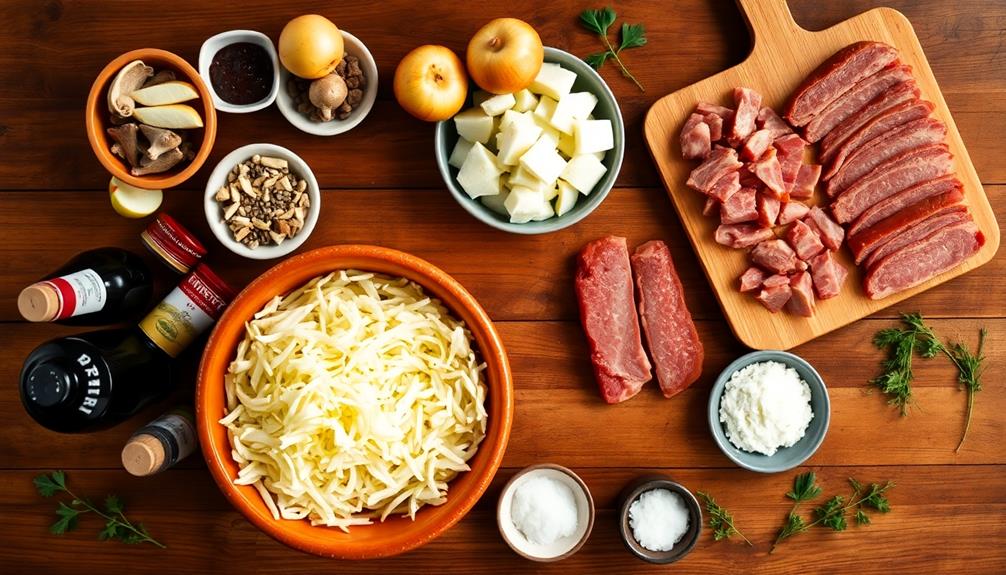
Finally, it's time to serve your delicious bigos. You've put in hours of effort, and now you get to enjoy the fruits of your labor! Grab a loaf of crusty bread to accompany this hearty stew. The bread's crunchy exterior and soft interior make it perfect for soaking up the rich, flavorful sauce.
Slice the bread into thick pieces, about an inch wide. If you'd like, you can toast them lightly for extra crunch. Arrange the slices on a plate or in a bread basket lined with a clean cloth napkin to keep them warm.
Ladle the steaming bigos into deep bowls, making sure each serving has a good mix of meat, cabbage, and other vegetables. The aroma will fill your kitchen, making everyone's mouths water.
Place a bowl in front of each person, along with a piece of bread on the side. Encourage your guests to tear off chunks of bread and dip them into the stew. It's a delicious way to savor every last bit of the bigos' complex flavors. Enjoy your meal!
Final Thoughts
Savor the rich traditions and hearty flavors of bigos, a timeless Polish dish that's sure to warm your soul. This hunter's stew isn't just a meal; it's a journey through Polish history and culture. As you enjoy each spoonful, you're tasting centuries of tradition and family gatherings. For an authentic taste of Poland, pair your bigos with a side of pierogi or a slice of rye bread. And if you’re looking to expand your culinary horizons, why not try your hand at a traditional huevos rancheros recipe for your next meal? Exploring different cultures through food is a delicious way to connect with the world around us.
Remember, bigos is incredibly versatile. Don't be afraid to make it your own by adding your favorite meats or vegetables. The longer it simmers, the better it gets, so patience is key.
If you have leftovers, you're in luck! Bigos tastes even better the next day, as the flavors continue to meld.
This hearty stew is perfect for cold winter nights, big family dinners, or when you're craving a taste of comfort food. It's a great way to use up leftover meats and vegetables, making it both delicious and practical.
Frequently Asked Questions
Can Bigos Be Frozen for Later Consumption?
Yes, you can freeze bigos for later consumption!
It's a great way to save time and enjoy this hearty dish whenever you want. Simply let the stew cool completely, then portion it into airtight containers or freezer bags.
Make sure to remove as much air as possible to prevent freezer burn. Your bigos will stay tasty for up to 3 months in the freezer.
When you're ready to eat, just thaw it overnight in the fridge and reheat gently on the stove.
How Long Does Bigos Typically Last in the Refrigerator?
You'll be happy to know that your delicious stew can last quite a while! Typically, it'll stay fresh in your refrigerator for 3-4 days.
Make sure you store it in an airtight container to keep it at its best. If you've made a big batch, don't worry! You can always freeze portions for later.
Just remember, the flavors often develop and improve over time, so it might taste even better on day two or three!
Are There Vegetarian or Vegan Versions of Bigos?
You'll be glad to know there are vegetarian and vegan versions of this hearty stew!
You can easily swap out the meat for plant-based alternatives like tofu, seitan, or mushrooms. These options give you that satisfying texture you're looking for.
Don't forget to use vegetable broth instead of meat-based stock. You'll still get those rich, comforting flavors from the sauerkraut, cabbage, and spices.
It's a delicious way to enjoy a traditional dish while sticking to your dietary choices!
What Are the Best Side Dishes to Serve With Bigos?
When you're serving up a hearty dish, you'll want some tasty sides to go with it!
Try crusty bread to soak up the flavorful juices. A crisp green salad adds a fresh touch.
Roasted potatoes or mashed potatoes are perfect for a comforting meal. Don't forget pickles or sauerkraut for a tangy kick!
For drinks, a cold beer or red wine pairs wonderfully.
These sides will make your meal even more delicious and satisfying!
Is Bigos Traditionally Eaten During Specific Seasons or Holidays?
You'll often find bigos served during colder months in Poland. It's a popular dish for Christmas Eve dinner and New Year's celebrations.
You might also enjoy it at fall harvest festivals or winter gatherings. The hearty stew's warming qualities make it perfect for chilly weather.
While there's no strict rule about when to eat bigos, its rich flavors and comforting nature make it a favorite choice when you're looking to cozy up during the cooler seasons.



